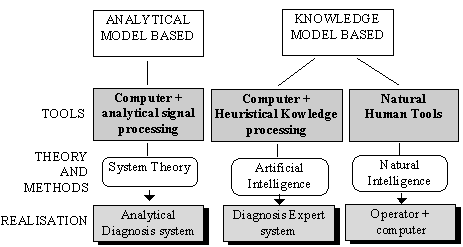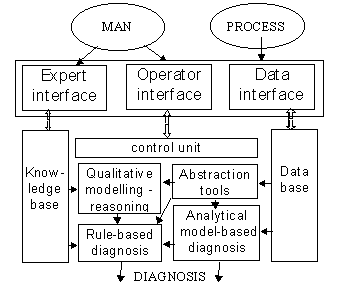
Fig. .8 Strategies for fault diagnosis
Fault diagnosis follows fault detection in the supervisory chain. According to the general description of fault detection systems, residual evaluation is an step preceding fault diagnosis. Constraints and conditions used in fault evaluation are submitted to particular faults. In these tasks, the use of intelligent decision systems offers a clear advantage because the use of expert knowledge about fault in the decision conditions. The use of AI techniques in this task can be combined with the analytical model used for fault detection.
Knowledge-based methods used in fault diagnosis.
The extensive domain of AI can be applied in different ways to diagnose about faults. In this sense, logical decisions needed in residual evaluation, can be performed by using fuzzy logic. Adaptive threshold for uncertain systems can be performed by fuzzy rules. In such situations, rules incorporate knowledge about process behaviour and the threshold is changed according to the operation conditions.
Another powerful technique from the AI domain are the Artificial Neural Networks. They have also been used in fault diagnosis with different purposes such as residual generation by replacing analytical models by trained networks and using them as a normal operating model. Residual evaluation can be improved by using neural networks using data from previous faults to train neural networks to solve theses situations.
Neural networks or fuzzy logic are AI technologies that can be used within analytical model-based fault detection for improving them. In fact, both neural networks and fuzzy logic use numerical data. Another different approach consists in using qualitative models (process models or faults models) for diagnosis as it has been introduced when talking about knowledge-based fault detection. In the case of a fault model, a previous knowledge about faults symptoms is assumed, then process is observed to match some of them. On the other hand, process-model is used to detect qualitative deviations from the normal operating mode.
Partial work of this thesis has been focused on the task of developing and integrating tools to assist knowledge-based design using the two last approaches. Main effort has been done in providing a useful tool for representing the simple qualitative relationship, ALCMEN, to perform qualitative observations of process variables submitted to faults. A case example has been developed to test both techniques. The use of ALCMEN to qualitatively estimate a non-measured variable is described in [Melendez et al. 1996a] , while the analysis of measured process variables in fault situations is used to obtain a qualitative description of faults in [Melendez et al. 1995]. In this case the use of rule-based ES under G2 was used to diagnose. The use of imprecise description of signals features, given by qualitative labels, as antecedents provoked sudden transitions in the ES decision because the ES was not able to mange this imprecision. This work was improved, by using a shell with fuzzy reasoning to deal with uncertainty and imprecision [Sàbat, 1996].
Sometimes the necessity of applying one of two methodologies, symptom- based or qualitative-model-based, is not clear and knowledge about fault situations and qualitative estimations of variables can be merged to improve the diagnose system. Moreover, it is necessary to combine both methodologies to take benefit of KB describing symptoms related to non measured variables, i.e. the qualitative observer. Former work of the author, with the same case example, has been extended in this sense as is explained in [Melendez et al., 1996b].
Diagnosis strategies.
Despite there does not exist a standard architecture for fault diagnosis, actual tendencies point to hybrid architectures because of the benefits of merging both technologies, (analytical and model-based approaches). Basic and pure lines are represented in Fig. 2.8 but drawbacks are presented in implementing simple strategies, due to the incompleteness of information when dealing with any proposal, especially with complex systems.

Fig. .8 Strategies for fault diagnosis
Supervision of complex systems (non-linear, time dependent, etc.) becomes impossible using analytical model-based approach because difficulty in obtaining accurate models. Despite of this drawback numerical methods must be taken into account for obtaining signal features that are needed by ES, representing expert knowledge, to deduce about behaviour of process variables. This thesis is particularly focused on combining all possible techniques in the implementation of complete supervisory systems. Fig. 2.7 represents the variety of information that can be used in the implementation of knowledge-based structures for fault detection and diagnosis.

Fig. .9 Hybrid, Knowledge and analytical based architecture for fault diagnosis
In this ways, the proposal of this thesis (Fig. 2.9) tries to take benefit of both knowledge and analytical tools, providing abstraction tools as numerical to qualitative interfaces. Qualitative reasoning and modelling are also present to roughly estimate process variables. Rule-based systems must be used together with analytical tools in the diagnosis tasks because data coming from process is purely numerical and process knowledge is referred to qualitative perceptions of them. In following chapters a set of tools are selected to be integrated in a commercial framework to facilitate the development of supervisory structures following this line.